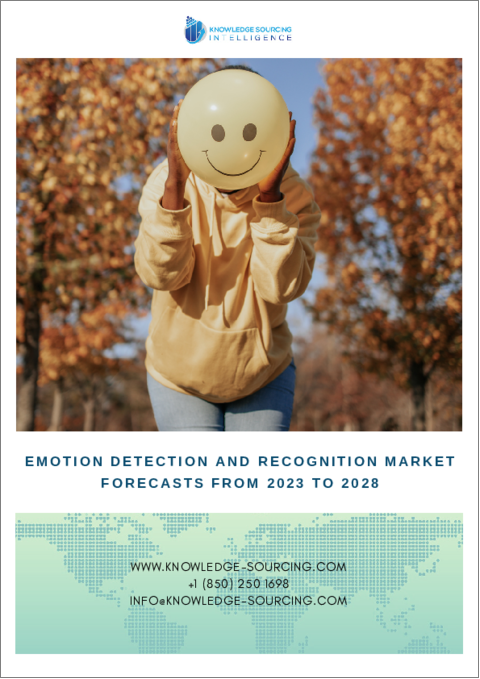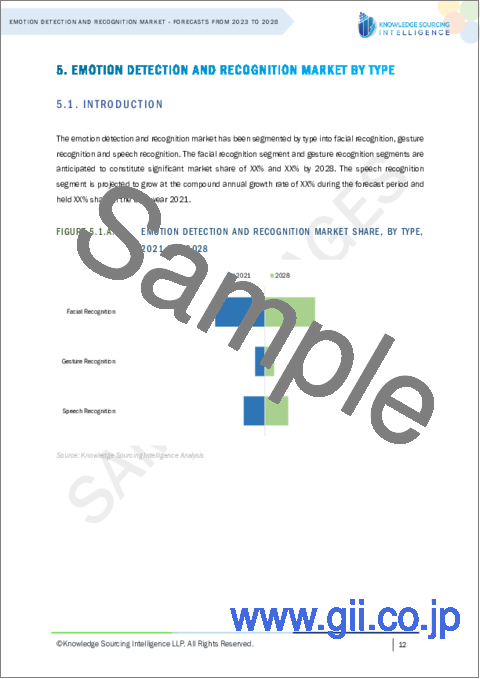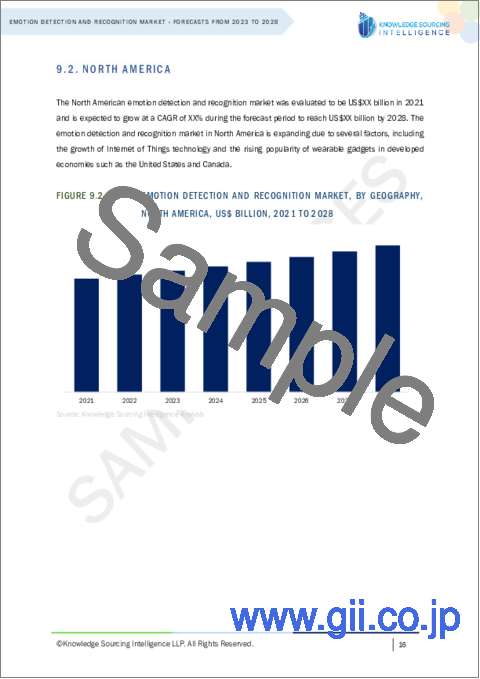|
|
市場調査レポート
商品コード
1279627
感情検出・認識市場-2023年から2028年までの予測Emotion Detection and Recognition Market - Forecasts from 2023 to 2028 |
||||||
|
● お客様のご希望に応じて、既存データの加工や未掲載情報(例:国別セグメント)の追加などの対応が可能です。 詳細はお問い合わせください。 |
|||||||
| 感情検出・認識市場-2023年から2028年までの予測 |
|
出版日: 2023年05月08日
発行: Knowledge Sourcing Intelligence
ページ情報: 英文 160 Pages
納期: 即日から翌営業日
|
- 全表示
- 概要
- 目次
感情検出・認識市場は、2021年の市場規模174億8,000万米ドルからCAGR11.71%で成長し、2028年には379億3,800万米ドルに達すると予測されます。感情検出・認識とは、機械学習アルゴリズム、人工知能ソフトウェア、自然言語処理、バイオセンサーシステムなどのさまざまなコンピュータ技術を統合し、顔、ジェスチャー、音声を分析して人間の感情を検出・認識するプロセスを指します。顔の動きを調べ、声の変調を分析し、体のジェスチャーを識別することで、ユーザーの感情状態を把握することができます。AI技術の進歩により、感情検出ソフトウェアの精度が相対的に向上し、その結果、感情認識ソフトウェアの消費量が増加しています。このソフトウェアによって、企業はユーザーの嗜好を理解することができます。感情的なフィードバックを受けることができるため、企業は自社製品を強化することができます。したがって、感情検出・認識市場は予測期間中に大きな成長を遂げることが予想されます。
オンラインマーケティング戦略の高まりが、感情検出・認識市場の需要を高めています。
Sprout Social Companyが発行したレポートによると、約93%の企業がソーシャルメディアの動画広告を通じて新規顧客を獲得し、顧客基盤を拡大しています。そのため、広告代理店やマーケティング会社は、コンテンツの効果を分析し、消費者の行動を検証して今後の参考にするために、感情検出・認識ソフトウェアの採用を検討しています。感情認識ソフトウェアの採用は、広告のさまざまな構成要素を徹底的に調査し、視聴者の感情と関連付けることを支援する可能性があります。そのため、デジタルマーケティングの発展が、感情認識・検出ソフトの需要を後押ししています。
感情検出ソフトウェアの使用に関連する倫理的な問題は、感情検出・認識市場の拡大を制限する可能性があります。
感情検出・認識市場の導入に伴うプライバシー侵害の倫理的問題は、複数の消費者の間で反発を招いています。米国国立標準技術研究所の調査によると、同国の成人の顔の約50%が顔認識ソフトのデータベースに記録されていることが明らかになりました。その結果、感情や顔検出ソフトによるプライベート空間の侵害を懸念する顧客が増加しています。例えば、ワシントン州では、政府機関において顔認証・生体認証ソフトウェアの使用を禁止する新たな法案を提出しました。公開会社が否定的な感情を抱いた結果、企業は感情AIの使用を自制しています。例えば、マイクロソフトは2022年に自社のクラウドベースのソリューションから感情検出ソフトの適用を取りやめました。そのため、感情検出・認識市場の開拓が制限される可能性があります。
感情AIなどの感情検出ソフトウェアを学校や教室に導入することで、クラスの雰囲気や子どもたちの感情状態を調べることができるようになります。
例えば、Find Solutions AIは香港の学校と協力し、小学生の顔の筋肉の動きを分析することで、小学生の感情のネガティブな変化とポジティブな変化を解釈しています。これにより、教師や学校関係者は、生徒の集中力や指導の効果についてより深く理解することができるようになります。学校のカリキュラムが複雑化し、生徒間の競合レベルが高くなったことで、精神的な問題や自殺事件が増加しています。例えば、インドの国家犯罪記録局は、2022年に学生の自殺事件がその前年の記録と比較して約4.5%増加したことを明らかにしました。したがって、感情検出ソフトウェアを適用することで、教育機関は学生の微小な動きを分析し、感情や心理的な幸福度を分析することが可能になります。したがって、教育分野における良好な感情的・心理的健康に対する要求の高まりが、感情検出・認識市場の成長を後押ししています。
北米は感情検出・認識市場で突出したシェアを占めており、予測期間中に大きく成長することが予想されます。
強力なAI技術市場の存在とコンピュータソフトウェアの急速な進歩が、北米の自動車や小売業を含むさまざまな産業における感情検出・認識市場の適用を刺激しています。また、Google、IBM、Microsoft、Appleといった北米の大手テクノロジー企業は、感情AIを含むあらゆる分野の人工知能ソフトウェアの新開発を革新するために積極的に投資しており、顧客により良いサービスを提供するために製品ポートフォリオの改善に常に努めています。ユーザーエクスペリエンスを向上させる試みとして、これらの企業は会話型チャットボットや感情検出ソリューションに人工知能ソフトウェアを導入しています。さらに、カナダと米国では、Wearehuman.io、Braiq、Nuralogix、Cynny、Mad Street Denといった感情認識ソフトウェアの作成を専門とする新しいAI技術スタートアップが出現しており、この地域における感情検出ソフトウェアの開発に機会を与えています。したがって、感情検出・認識市場は予測期間中に徐々に成長すると予想されます。
目次
第1章 イントロダクション
- 市場概要
- 市場の定義
- 調査範囲
- 市場セグメンテーション
- 通貨
- 前提条件
- 基準年と予測年のタイムライン
第2章 調査手法
- 調査データ
- 調査デザイン
第3章 エグゼクティブサマリー
- 調査ハイライト
第4章 市場力学
- 市場促進要因
- 市場抑制要因
- ポーターのファイブフォース分析
- 業界バリューチェーン分析
第5章 感情検出・認識市場:タイプ別
- イントロダクション
- 顔認識
- ジェスチャー認識
- 音声認識
第6章 感情検出・認識市場:技術別
- イントロダクション
- バイオセンサー
- 自然言語処理
- 機械学習
第7章 感情検出・認識市場:用途別
- イントロダクション
- ゲーム
- 仮想アシスタント
- 監視
- 募集
- その他
第8章 感情検出・認識市場:エンドユーザー別
- イントロダクション
- 自動車
- 家電
- 政府
- ヘルスケア
- 教育
- その他
第9章 感情検出・認識市場:地域別
- イントロダクション
- 北米
- 米国
- カナダ
- メキシコ
- 南米
- ブラジル
- アルゼンチン
- その他
- 欧州
- 英国
- ドイツ
- フランス
- イタリア
- スペイン
- その他
- 中東・アフリカ
- サウジアラビア
- アラブ首長国連邦
- その他
- アジア太平洋
- 中国
- 日本
- インド
- 韓国
- オーストラリア
- シンガポール
- インドネシア
- その他
第10章 競合環境と分析
- 主要企業と戦略分析
- 新興企業と市場収益性
- 合併、買収、合意およびコラボレーション
- ベンダー競争力マトリックス
第11章 企業プロファイル
- Affective
- Apple Inc.
- Microsoft Corporation
- Eyeris Technology Inc.
- Noldus Information Technology BV
- MorphCast
- AritaWeb
- audEERING GmbH
- NVISO SA
- Paravision
The emotion detection and recognition market is expected to grow at a CAGR of 11.71% from a market size of US$17.48 billion in 2021 to reach US$37.938 billion in 2028. Emotion detection and recognition refers to the process of integrating different computer technologies including machine learning algorithms, artificial intelligence software, natural language processing, and biosensor systems to detect and recognize human emotions by analyzing their face, gestures, and voice. It examines facial movements, analyzes voice modulation, and identifies body gestures to provide insight into the emotional state of the user. The technological advancements in AI technology have resulted in a relative increase in the accuracy of emotion detection software which is resulting in higher consumption of emotion recognition software. This software allows companies to understand the preferences of their users. The ability to receive emotional feedback can help companies to enhance their products. Therefore, it can be expected that the emotion detection and recognition market will witness significant growth over the forecast period.
The rise in online marketing strategies have resulted in a higher demand for the emotion detection and recognition market.
According to a report published by Sprout Social Company, approximately 93% of companies have expanded their customer base by gaining new customers through social media video advertisements. As a result, advertising agencies and marketing companies are considering the adoption of emotion detection and recognition software to analyze the effectiveness of their content and examine consumers' behavior for future reference. The employment of emotion recognition software could aid companies in thoroughly investigating the different components of their advertisements and correlating them with the emotions of the viewers. Therefore, the growth of digital marketing is driving the demand for emotion recognition and detection software.
The ethical issues associated with the use of emotion detection software could limit the expansion of the emotion detection and recognition market.
The ethical issues of privacy violation as a result of the implementation of the emotion detection and recognition market are causing a backlash among several consumers. Research conducted by the National Institute of Standards and Technology in the US revealed that approximately 50% of adult faces in the country have been recorded in the facial recognition software database. Consequentially, an increasing number of customers are concerned about the invasion of their private space by emotion and facial detection software. For instance, the state of Washington has introduced a new bill to prohibit the use of facial and biometric recognition software in its government departments and agencies. As a result of the negative sentiment among the public, companies have restrained the use of emotional AI. For example, Microsoft withdrew the application of emotion detection software from its cloud-based solutions in 2022. Therefore, this could potentially limit the development of the emotion detection and recognition market.
Key Developments
- In July 2022, Lightbulb Ai, an emotional AI startup in India secured an additional investment of US$1.5 million to expand its datasets and strengthen its machine learning algorithms. This startup has four clients including a Columbian company and is planning on using the investment to expand its operations to cater to the international market.
- In May 2021, Smart Eye, a Swedish company producing software services to track eye movements acquired Affectiva, a US company specializing in the production of emotion recognition software, for US$73.5 million to diversify their vehicle interior sensing capabilities.
- In January 2021, Herta Security launched a new emotion detection software BioObserver by collaborating with its clients in the law execution department to analyze videos and identify emotions based on the micro-movements in the facial biometrics including orientation of the head and the direction of the gaze of a person.
The implementation of emotional AI and other emotion detection software in schools and classrooms provides an opportunity to examine the class atmosphere and the emotional state of the children.
For instance, Find Solutions AI has collaborated with schools in Hong Kong to interpret the negative and positive changes in the emotions of school children by analyzing their facial muscle movements. This can assist the teachers and school faculty to gain a better understanding of the student's concentration ability and the effectiveness of their teaching. The increasing complexity of school curriculum and high competition levels among students has resulted in an increase in the number of mental health issues and suicide incidents. For instance, the National Crime Records Bureau of India revealed that suicide incidents among students increased by approximately 4.5% in 2022 in comparison with its previous year's records. Therefore, the application of emotion detection software could enable educational institutions to analyze micro-movements in students to analyze their emotional and psychological well-being. Hence, the increasing requirement for good emotional and psychological health in the education sector propels the growth of the emotion detection and recognition market.
North America holds a prominent share of the emotion detection and recognition market and is expected to grow significantly over the forecasted period.
The presence of a strong AI technology market and the rapid advancements in computer software are stimulating the application of the emotion detection and recognition market across different industries including the automotive and retail sectors in North America. In addition, leading technology companies in North America like Google, IBM, Microsoft, and Apple are actively investing to innovate new developments in artificial intelligence software in all fields including emotional AI, and are constantly striving to improve their product portfolio to offer better services to their customers. In an attempt to improve the user experience, these companies have been implementing artificial intelligence software in conversational chatbots and emotion detection solutions. Further, the emergence of new AI-tech startups in Canada and the US specializing in the creation of emotion recognition software such as Wearehuman.io, Braiq, Nuralogix, Cynny, and Mad Street Den provides an opportunity for the development of emotion detection software in the region. Hence, it can be anticipated that the emotion detection and recognition market will gradually grow over the forecast period.
Market Segmentation
By Type
- Facial Recognition
- Gesture Recognition
- Speech Recognition
By Technology
- Biosensors
- Natural Language Processing
- Machine Learning
By Application
- Gaming
- Virtual Assistants
- Surveillance
- Recruitment
- Others
By End-Users
- Automotive
- Consumer Electronics
- Government
- Healthcare
- Education
- Others
By Geography
- North America
- USA
- Canada
- Mexico
- South America
- Brazil
- Argentina
- Others
- Europe
- United Kingdom
- Germany
- France
- Italy
- Spain
- Others
- Middle East and Africa
- Saudi Arabia
- UAE
- Others
- Asia Pacific
- China
- Japan
- India
- South Korea
- Australia
- Singapore
- Indonesia
- Others
TABLE OF CONTENTS
1. INTRODUCTION
- 1.1. Market Overview
- 1.2. Market Definition
- 1.3. Scope of the Study
- 1.4. Market Segmentation
- 1.5. Currency
- 1.6. Assumptions
- 1.7. Base, and Forecast Years Timeline
2. RESEARCH METHODOLOGY
- 2.1. Research Data
- 2.2. Research Design
3. EXECUTIVE SUMMARY
- 3.1. Research Highlights
4. MARKET DYNAMICS
- 4.1. Market Drivers
- 4.2. Market Restraints
- 4.3. Porter's Five Forces Analysis
- 4.3.1. Bargaining Power of Suppliers
- 4.3.2. Bargaining Power of Buyers
- 4.3.3. Threat of New Entrants
- 4.3.4. Threat of Substitutes
- 4.3.5. Competitive Rivalry in the Industry
- 4.4. Industry Value Chain Analysis
5. EMOTION DETECTION AND RECOGNITION MARKET BY TYPE
- 5.1. Introduction
- 5.2. Facial Recognition
- 5.3. Gesture Recognition
- 5.4. Speech Recognition
6. EMOTION DETECTION AND RECOGNITION MARKET BY TECHNOLOGY
- 6.1. Introduction
- 6.2. Biosensors
- 6.3. Natural Language Processing
- 6.4. Machine Learning
7. EMOTION DETECTION AND RECOGNITION MARKET BY APPLICATION
- 7.1. Introduction
- 7.2. Gaming
- 7.3. Virtual Assistants
- 7.4. Surveillance
- 7.5. Recruitment
- 7.6. Others
8. EMOTION DETECTION AND RECOGNITION MARKET BY END-USERS
- 8.1. Introduction
- 8.2. Automotive
- 8.3. Consumer Electronics
- 8.4. Government
- 8.5. Healthcare
- 8.6. Education
- 8.7. Others
9. EMOTION DETECTION AND RECOGNITION MARKET BY GEOGRAPHY
- 9.1. Introduction
- 9.2. North America
- 9.2.1. USA
- 9.2.2. Canada
- 9.2.3. Mexico
- 9.3. South America
- 9.3.1. Brazil
- 9.3.2. Argentina
- 9.3.3. Others
- 9.4. Europe
- 9.4.1. United Kingdom
- 9.4.2. Germany
- 9.4.3. France
- 9.4.4. Italy
- 9.4.5. Spain
- 9.4.6. Others
- 9.5. Middle East and Africa
- 9.5.1. Saudi Arabia
- 9.5.2. UAE
- 9.5.3. Others
- 9.6. Asia Pacific
- 9.6.1. China
- 9.6.2. Japan
- 9.6.3. India
- 9.6.4. South Korea
- 9.6.5. Australia
- 9.6.6. Singapore
- 9.6.7. Indonesia
- 9.6.8. Others
10. COMPETITIVE ENVIRONMENT AND ANALYSIS
- 10.1. Major Players and Strategy Analysis
- 10.2. Emerging Players and Market Lucrativeness
- 10.3. Mergers, Acquisitions, Agreements, and Collaborations
- 10.4. Vendor Competitiveness Matrix
11. COMPANY PROFILES
- 11.1. Affective
- 11.2. Apple Inc.
- 11.3. Microsoft Corporation
- 11.4. Eyeris Technology Inc.
- 11.5. Noldus Information Technology BV
- 11.6. MorphCast
- 11.7. AritaWeb
- 11.8. audEERING GmbH
- 11.9. NVISO SA
- 11.10. Paravision




